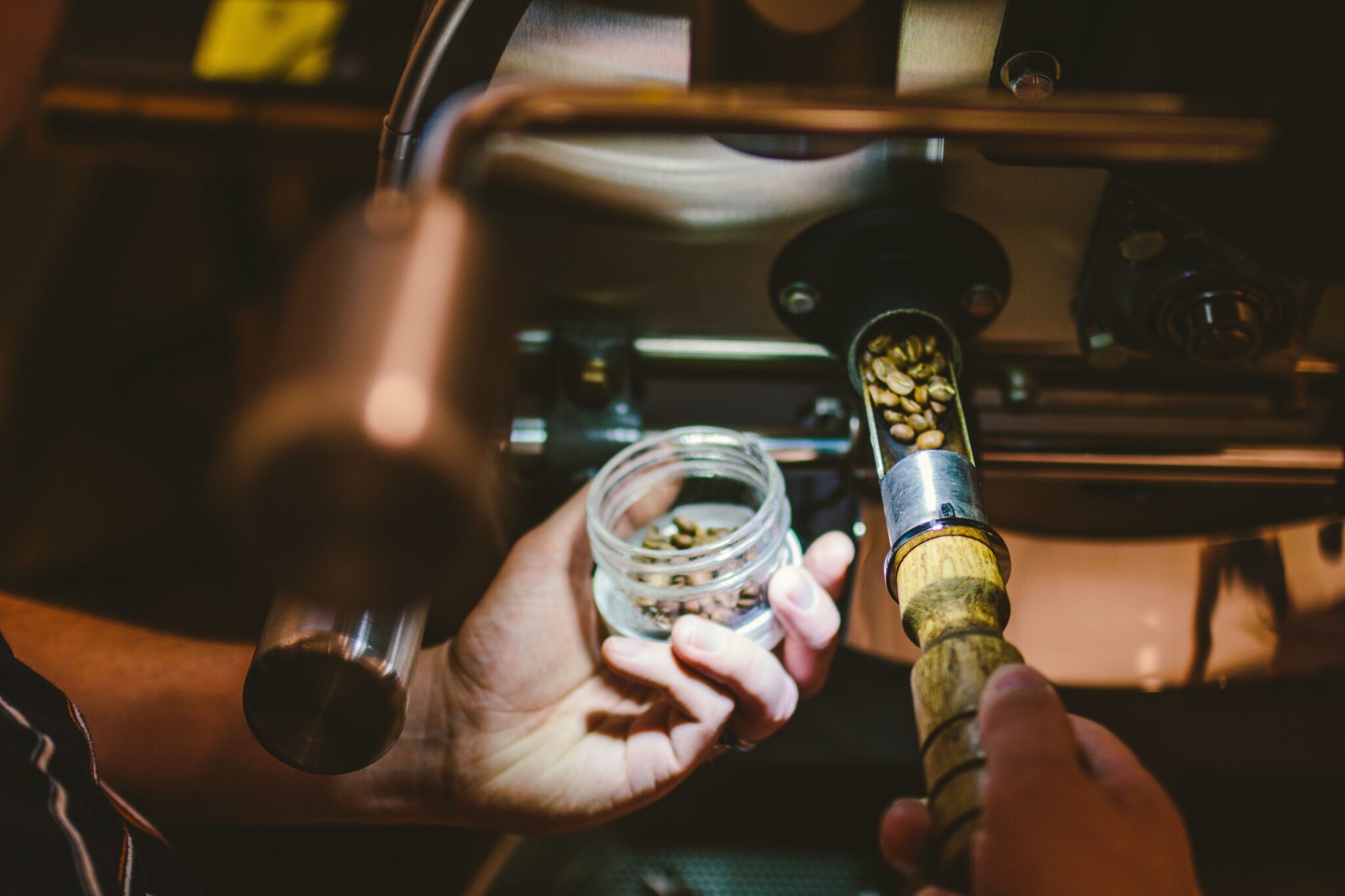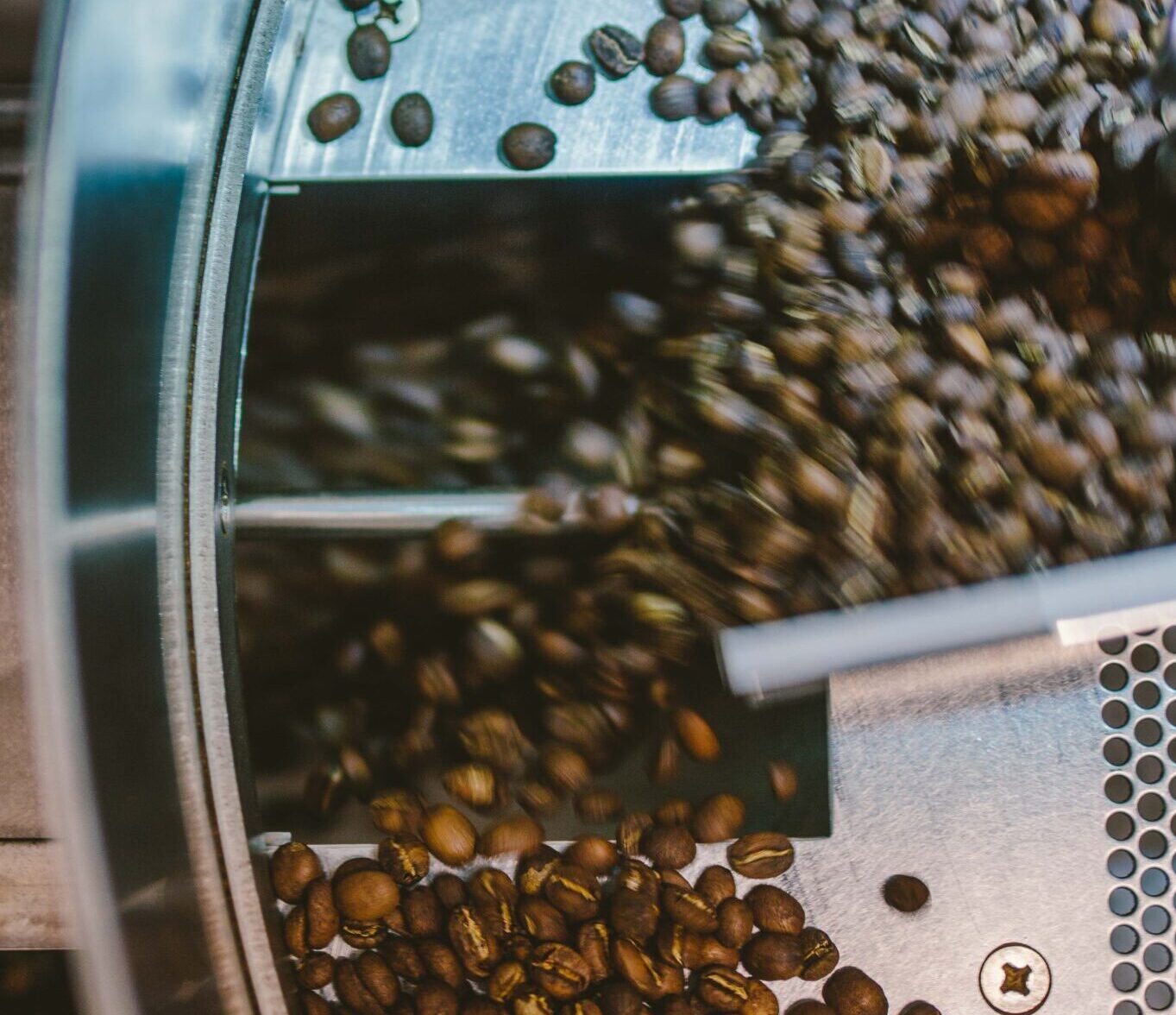We all know that our coffee beans are roasted before we use them but the details of what actually happens in the roasting process and why it is necessary may not be as clear.
This blog is intended as a quick, and relatively accessible guide to a process which is highly skilled and incredibly technical, and at the same time completely subjective, instinctive and creative. Before we look at the roasting, it is worth remembering that at the very beginning of the journey which eventually delivers your roast coffee beans for grinding and brewing, is a coffee plant laden with coffee “cherries”. When the cherries have been picked, the fruit pulp and the skin are removed before the beans are washed and allowed to dry, this is known as the “washed process”, in the alternative “natural process” the cherries dry whole and the skin and dried pulp are removed after drying. The beans are then ready to be exported though they can be stored for a relatively long time without any harm before being roasted.
The most common roasting machines are either drum roasters, where a horizontally mounted drum rotates while heat is applied underneath, or hot air roasters, where hot air is distributed through the beans via a screen below them. The drum roasting method is stable and slower than hot air, and it gives the roaster more time to react and intervene in the roast as the constant motion prevents the beans from touching a heated surface for any extended period, which means that the beans are less prone to burning. Hot air roasting is faster, but the speed is not at the price of any added danger of burning as there are no directly heated surfaces with which the beans can come into contact.
There are other types of roasters and hybrids of the different varieties but what unites them is that by the application of heat, science and the skill of a master roaster they turn the beans into something completely new. When these dense, compact green coffee beans are eventually roasted, the process completely transforms them. What arrives in the coffee shop or your home is no longer a hard, dry coffee bean: roasting makes it much darker, slightly oily, larger, lighter in weight and ready to be used to make a delicious cup of coffee.
One of the most immediately obvious changes is the colour, their brown-green colour becomes a blotchy yellow as they heat up and then this changes to brown when the sugars and amino acids in the beans combine under the heat to produce melanoidins. The longer the roast, the darker the beans become and the stronger the flavour, hence coffee often being referred to as light, medium or dark roasted.


During roasting, the water content of the beans is drastically reduced and with the loss of moisture comes the loss of weight. Accompanying the loss of weight, though, is an increase in size. This is because the water which is lost during the process is transformed into gas and this increases the pressure inside the beans and the beans expand. Most of this gas is carbon-dioxide and this continues to be released by the beans after the roasting has finished in a process known as degassing.
This expansion, loss of water and increased internal gas pressure combine to break down the density of the beans which makes them more soluble and porous. This contributes to extraction of flavour from the ground beans.
The roasting profile is comprised of three elements: drying, browning/Maillard reaction and development.
When the cold beans are added to the pre-heated roaster, the temperature in the machine drops briefly before it starts to rise again. The moment that the temperature starts to recover is known as the turning point and this is when the drying phase starts. The drying phase is when the water in the beans begins to vaporise and the pressure in the beans starts to build.
At around 150C/302F the Maillard Reaction starts and the melanoids, which change the colour of the beans and contribute to the body and mouthfeel of the coffee, develop. During the Maillard reaction gases are created in the beans including carbon dioxide, as is water vapour and some volatile compounds. The internal pressure increases until towards the end of the Maillard reaction the cell walls break, making a popping noise which is known as the first crack. The duration of the Maillard reaction can be manipulated to create an impact on the final flavour profile of a coffee. Roasters will manipulate the length of the process: shortening it or lengthening it to encourage different flavours to develop in the beans.
Involved with the Maillard reaction is the Stecker Degradation in which compounds such as aldehydes and ketones are produced which are essential for the creation of aroma and flavour producing compounds. This is also the process which is responsible for the crema produced when making a shot of espresso.
Around the time of the end of the Maillard reaction and the start of the development comes that popping sound, the first crack. The development, which starts after the Maillard reaction, is when the roast process changes from an endothermic reaction, where the beans absorb heat from the drum, to an exothermic reaction, where the beans release heat. During this time the beans become more porous, oils migrate to the walls of the cell and the beans darken further. These oils, or lipids, help keep the volatile compounds, which create the flavour and aroma of the coffee, within the coffee beans. As the beans are now producing their own heat the temperature is carefully assessed to achieve the intended level of roast and development before the beans are cooled.


Once the development is complete the roasting process needs to be arrested before the coffee becomes over-roasted. To do this, the beans are released from the roaster onto a tray where a fan cools them quickly to prevent them from continuing to roast due to their own internal heat. Soon after this the beans are quickly packed and dispatched for use, as the “volatile” compounds at the heart of the final cup of coffee are well named and can lose their vibrancy quickly if the beans aren’t used while they are still fresh.
Interested in our Coffee?
We have a wide selection single origin coffees and blends that we know you will love. Our roasting team work hard to ensure that these coffees are perfect every single time.
Veiw our coffees
